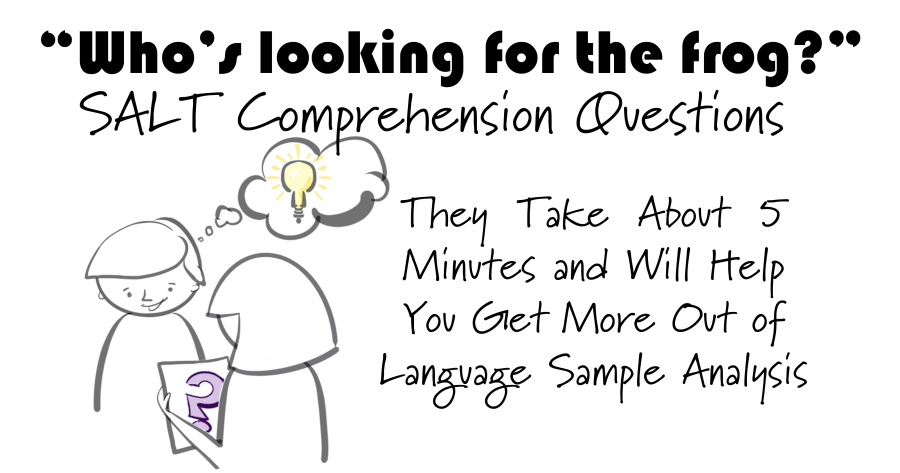
“Who is looking for the frog?”

“Who is looking for the frog?”
Published at: 2019-11-13
SALT Comprehension Questions Take About 5 Minutes and Will Help You Get More Out of Language Samples
A few years back SALT developed comprehension questions for each of the story retell language sample elicitations. Can I just say that I love these add-on questions! They are based on the revised Bloom’s Taxonomy(1) with a framework of questions in a hierarchy going from easy to more complex higher-level thinking questions. The questions fall into six categories: remembering, understanding, applying, analyzing, evaluating, and creating. There are three questions for each of the six categories. For example, a remembering question might be: “Who is looking for the frog?” or “What kind of an animal is Dr. DeSoto?” Whereas, a creating question might be: “How could you keep the frog from escaping? or “What else could Dr. DeSoto have done to protect himself from the fox?” Here are a few reasons to love the story retell comprehension questions. Reason 1: Classroom Correlation These questions are well-aligned with what kids are exposed to in English and Language Arts curricula at school. Listening comprehension is one facet of reading that’s crucial to becoming a proficient reader. At my school, the literacy facilitator spends a lot of instruction time on analyzing text and then works on leveled questions. She defines a level-one question as “answers that you can put your finger on” (literally find the answer in the text), which is essentially the same as a “remembering” question. There is not a lot of higher-level thinking needed for these types of questions. Kids then have to answer more complex and inferential questions. Teachers have great insights about students’ ability to answer questions in class, and these questions can help substantiate impressions or classroom data from teachers. I like that the SALT story retell questions align with the demands of the classroom; they are a very functional assessment. Reason 2: Bilingual Version Bilingual evaluations are often just a bit trickier and more time consuming. I’m always looking for functional and non-biased assessment options to add to my bilingual diagnostic toolkit. Transcripts of language samples from the Mercer Mayer frog stories are available in the SALT reference database for bilingual Spanish/English speakers. The comprehension questions are available in both English and Spanish as well! So, I can use the outcome from these questions as another data point when comparing English and Spanish comprehension skills to determine if a bilingual student may have language difficulty. Reason 3: Alignment with Other Assessments This is just a clinical impression, but I’ve been surprised a few times by how well the results of these questions align with other testing when we are doing a whole-team evaluation. As an example, I recently administered these questions to a third grader. Surprisingly, she performed very poorly on the “remember” questions, which kids usually have less difficulty answering. However, once the evaluation team sat down and went over her other assessment results, the school psychologist shared that the student’s working memory score was very low. The outcome from the comprehension questions then made total sense. I love it when testing lines up! It makes me feel validated regarding my own clinical findings and impressions. Reason 4: Quick and Easy We are all crunched for time! These questions take less than five minutes to administer and I score them as I go. SALT has the questions corresponding to each story available in a tear-off pad making it easy to store with the elicitation books and then transfer to a student file. The scoring scheme is simple: 0, 1, or 2 for each question. SALT has some examples which provide a little more guidance on how to score (there is a link to a helpful video below). I report the score as a percent and then offer insights as to which question types the student had difficulty with and where they showed strengths. Reason 5: Aha! Moments Since I’ve already collected the corresponding language sample, I nearly always take the five extra minutes to pose the comprehension questions to my students. When I transcribe the language sample, I get a very focused look at the productive language relating to the story. And then I look at the relationship between the comprehension question results and the SALT analysis of the story retell. Often, I get an “aha” moment. I find myself saying, “now that makes sense,” or “sure, that’s why she struggled there.” The comprehension and production outcomes are pieces to the puzzle and the puzzle pieces are fitting together. Because of the extra five minutes from the comprehension questions, I get even more out of the time I invested into collecting a language sample. I encourage you to try these out - use them! These questions are quick and easy and offer another piece of data to help inform your comprehensive evaluation. I bet you will love them as much as I do! Watch this video for more information on the comprehension questions. _____________ (1) Bloom, B. S., Englehart, M. D., Furst, E. J., Hill, W. H., & Krathwohl, D. R. (1956). Taxonomy of educational objectives: Handbook I. Cognitive domain. New York: David McKay. See Also: Anderson, L. W., Krathwohl, D. R., & Bloom, B. S. (2001). A Taxonomy for Learning, Teaching, and Assessing: A Revision of Bloom’s Taxonomy of Educational Objectives. Allyn & Bacon. Boston, MA. Wilson, L. O. (2013). Anderson and Krathwohl - Bloom’s Taxonomy Revised. The Second Principle. The work of Leslie Owen Wilson. Ed. D. Can be retrieved at http://thesecondprinciple.com/teaching-essentials/beyond-bloom-cognitive-taxonomy-revised.
No Comments yet. Be the first to comment.